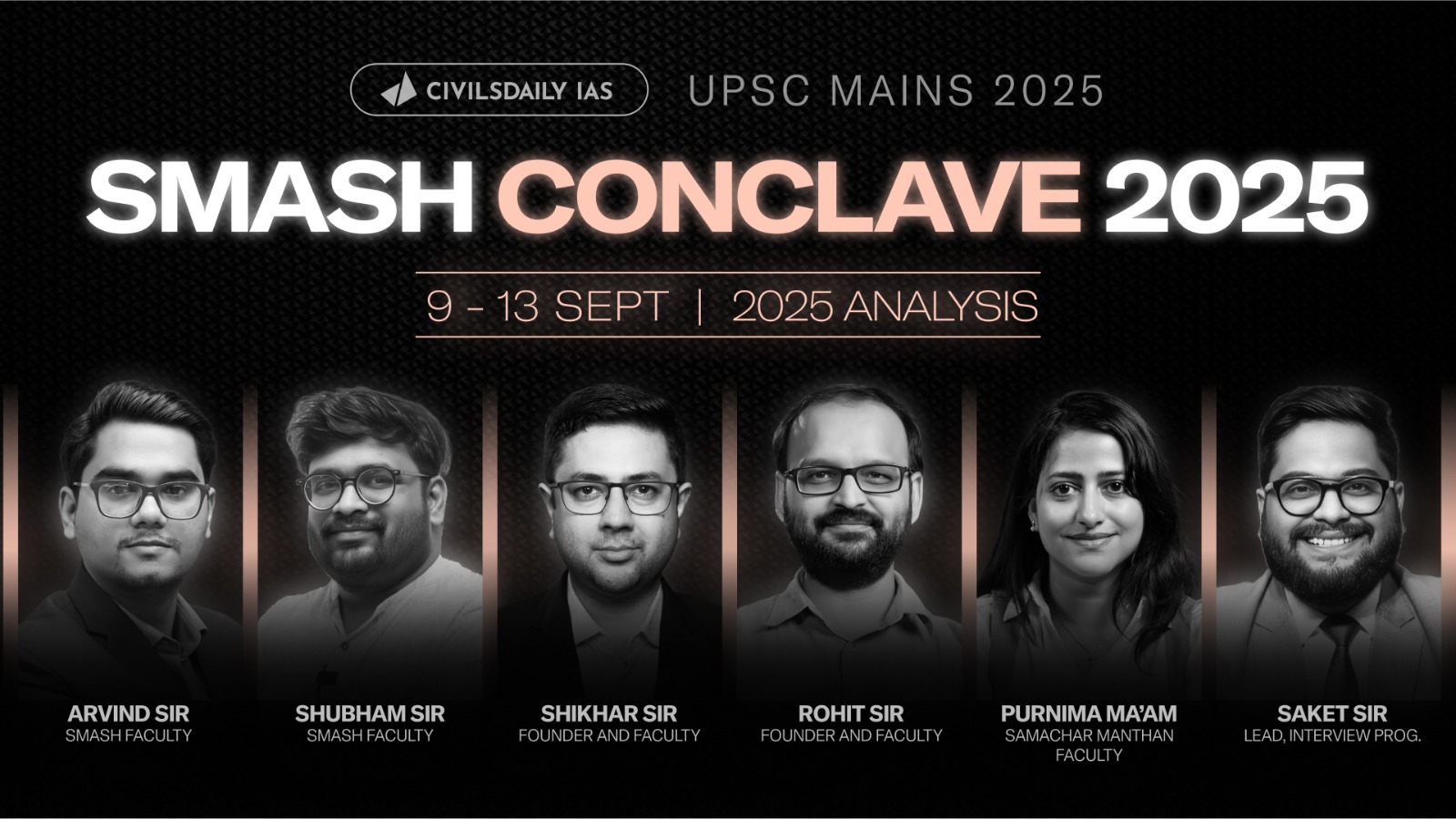Note4Students
From UPSC perspective, the following things are important :
Prelims level: Not much
Mains level: Paper 3- Factors making Naxal moment a complex security challenge
The article explains the issues with the two common themes adopted for explaining the Naxal movement in India.
Two approaches to explain Naxal movement
1) Root cause and alienation approach
- The recent attack in and around Tekulagudem village in Sukma district demonstrates the threat posed by Maoists.
- The post-incident analysis of such setbacks comes in two flavours.
- The most popular theory amongst our intelligentsia and media is the root cause and alienation approach.
- This approach states that it is the failure of the Indian state to provide economic development and social justice to the tribals living in these areas that has fuelled the Naxal movement and sustained it for five decades.
- As a prescription, a development-centric approach and negotiations are suggested as the way forward.
Issues with root cause and alienation approach
- There are several problems with this approach.
- First, it ignores the ideological foundations of the movement, specifically its rejection of India’s Constitution and democracy.
- Second, it fails to see that social and economic deprivation is not unique to the jungles of Chhattisgarh.
- Third, it doesn’t account for the possibility that while alienation and deprivation may help in igniting the spark of revolution, once lit the flames draw oxygen from many sources.
- Fourth, the role of external forces in fomenting and sustaining this movement is deliberately underplayed.
- Fifth, the grubby ground reality of the praxis of revolution is conveniently swept under the carpet.
- The organised extortion racket from all economic stakeholders in the Naxal-affected areas by our alienated revolutionaries seldom gets talked about.
- Sixth, the extensive ideological, financial and logistical ecosystem that provides sustenance to these revolutionaries in the jungle is seldom acknowledged.
2) Leadership issue
- According to this view, our tactical failures against the Maoists are entirely due to the poor quality of leadership provided by the Indian Police Service.
- The when, where, how of a setback simply don’t matter.
- When in doubt, identify the first IPS officer in the chain of command and hoist him on the petard of tactical incompetence.
- This view completely ignores the many successes of IPS leadership in counterinsurgency operations in Punjab, Andhra Pradesh, Uttar Pradesh and most recently in Odisha.
- Even in the Northeast and Jammu and Kashmir, where the Indian Army provides the backbone of the counterinsurgency grid, the police forces of the respective states and their IPS leadership play a crucial role in gathering intelligence and in executing operations.
- So, the failures and setbacks in the Naxal areas of Chhattisgarh need to be placed in perspective.
Way forward
- The fact that the Indian state has adopted a broad policy of economic development, military restraint and gradual attrition and rejected indiscriminate violence in the Naxal theatre is the democratically prudent and morally just course of action.
- This hasn’t dissuaded Maoist sympathisers from gaining international attention through relentless propaganda against our security forces.
- However, such attacks also help in exposing their true nature and hardening public resolve against them.
- \We have enough examples of successful, police led CI Ops in our country.
- Why we are not able to replicate these successes in Chhattisgarh is a matter of larger political issues, well beyond the narrow scope of operational tactics and individual lapses of police leadership.
- Not just the politics, the geography and demography of the Naxal-affected areas, make it an even more complex challenge of internal security.
Consider the question “What are the factors that make Naxal movement a persistent threat to India’s internal security? ”
Conclusion
Not just the politics, the geography and demography of the Naxal-affected areas, make it an even more complex challenge of internal security.
Get an IAS/IPS ranker as your 1: 1 personal mentor for UPSC 2024
Attend Now
Note4Students
From UPSC perspective, the following things are important :
Prelims level: Agri exports
Mains level: Paper 3- Agri exports
Consistent trade surplus in agricultural products
- India has consistently maintained trade surplus in the agricultural products over the years.
- The export of Agri and allied commodities during Apr, 2020 – Feb,2021 were Rs. 2.74 lakh Crore as compared to Rs. 2.31 Crore in the same period last year indicating an increase of 18.49%.
- The imports of Agri and allied commodities during April, 2020 – Feb, 2021 were Rs. 1.41lakh Crore as compared to Rs. 1.37 lakh Crore in the same period last year witnessing a slight increase of 2.93%.
Commodities that posted positive growth
- India has witnessed tremendous growth of 727 % for Wheat export.
- On specific demand from countries, NAFED has exported 50,000 MT wheat to Afghanistan and 40,000 MT wheat to Lebanon under G2G arrangement.
- Country has witnessed significant growth of 132% in export of (Non-Basmati) Rice.
- Export of Non-Basmati Rice has gone up from Rs 13,030 crores in 2019-20 to Rs 30,277 crores in 2020-21.
- This increase in exports is on account of multiple factors, mainly being India capturing new markets namely, Timor-Leste, Papua New Guinea, Brazil, Chile, and Puerto Rico.
- Exports were also made to Togo, Senegal, Malaysia, Madagascar, Iraq, Bangladesh, Mozambique, Vietnam, Tanzania Rep and Madagascar.
- India also enhanced export of Soya meals by 132%. Soya meal has gone up from Rs 3087 crores in 2019-20 to Rs 7224 crores in 2020-21.
Get an IAS/IPS ranker as your 1: 1 personal mentor for UPSC 2024
Attend Now
Note4Students
From UPSC perspective, the following things are important :
Prelims level: Epithelial cell
Mains level: Paper 2-Oxygen requirement in covid patients
How Covid-19 leads to shortness of breath?
- Shortness of breath occurs because of the way Covid-19 affects the patient’s respiratory system.
- When a person inhales, the tiny air sacs in the lungs — alveoli — expand to capture this oxygen, which is then transferred to blood vessels and transported through the rest of the body.
- Respiratory epithelial cells line the respiratory tract.
- Their primary function is to protect the airway tract from pathogens and infections, and also facilitate gas exchange.
- And the SARS-CoV-2 coronavirus can infect these epithelial cells.
- To fight such infection, the body’s immune system releases cells that trigger inflammation.
- When this inflammatory immune response continues, it impedes the regular transfer of oxygen in the lungs.
- Simultaneously, fluids too build up.
- Both these factors combined make it difficult to breathe.
- Low levels of oxygen triggered by Covid-19 are inflammatory markers, which include elevated white blood cell counts and neutrophil counts.
Does a patient always show Covid symptoms when their oxygen levels drop?
- No.
- According to the FAQs on Covid-19 from AIIMS e-ICUS, sudden deaths have been reported at presentation to the emergency department, as well as in hospital.
- AIIMS has said that the reasons that have been proposed include a sudden cardiac event, preceding “silent hypoxia” that went unnoticed, or due to a thrombotic complication such as pulmonary thromboembolism.
- In silent hypoxia, patients have extremely low blood oxygen levels, yet do not show signs of breathlessness.
Get an IAS/IPS ranker as your 1: 1 personal mentor for UPSC 2024
Attend Now
Note4Students
From UPSC perspective, the following things are important :
Prelims level: World Press Freedom Index
Mains level: Paper 2- Freedom of press in India
Where India stands on freedom of press
- India is ranked at 142 out of 180 countries on the World Press Freedom Index 2021.
- India at142th position is same as last year, after it had consistently slid down from 133 in 2016.
- In the South Asian neighbourhood, Nepal is at 106, Sri Lanka at 127, Myanmar (before the coup) at 140, Pakistan at 145 and Bangladesh at 152.
- The index is published by the international journalism not-for profit body, Reporters Without Borders (RSF).
- China is ranked 177, and is only above North Korea at 179 and Turkmenistan at 178.
What the report said about India
- The report released on Tuesday stated that India shares the “bad” classification with Brazil, Mexico and Russia.
- RSF has highlighted that the “campaigns are particularly violent when the targets are women”.
- Further, it said that criminal prosecutions are meanwhile “often used to gag journalists critical of the authorities” with sections for sedition also used.
- Speaking about the larger Asia-Pacific region, the report mentioned that “instead of drafting new repressive laws in order to impose censorship, several of the region’s countries have contented themselves with strictly applying existing legislation that was already very draconian – laws on ‘sedition,’ ‘state secrets’ and ‘national security’.”
- The report has also highlighted throttling of freedom of expression on social media, and specifically mentioned that in India the “arbitrary nature of Twitter’s algorithms also resulted in brutal censorship”
Measures adopted by India to improve ranking
- The Indian government has been concerned about its low rankings in such international indices, and had last year started studying them to understand how to improve.
- Soon after the index was released last year, Union Minister for Information and Broadcast had tweeted on May 2: “Media in India enjoy absolute freedom.”
Get an IAS/IPS ranker as your 1: 1 personal mentor for UPSC 2024
Attend Now
Note4Students
From UPSC perspective, the following things are important :
Prelims level: Article 224A
Mains level: Paper 2- Appointment of retired judges in the High Court under Article 224A
Appointment of retired judges under Article 224A
- The Supreme Court cleared the way for appointment of retired judges as ad-hoc judges in High Courts under Article 224A of the Constitution.
- The court ruled that the Chief Justice of a High Court may initiate the process of recommending a name if the number of judges’ vacancies is more than 20 per cent of the sanctioned strength.
- The court said the appointments can follow the procedure laid down in the Memorandum of Procedure for appointment of judges.
- The move will help to deal with mounting backlog of cases.
- Since the nominees have been judges before, the need to refer the matter to the IB or other agencies would not arise, shortening the time period.
Back2Basics: About Article 224A
- It allows the Chief Justice of a High Court to allow a retired judge of any High Court to sit and act as the judge of the High Court for that State.
- Previous consent of the President is necessary.
- The acting retired judge would be entitled to such allowances as the President may by order determine and have all the jurisdiction, powers and privileges of, but shall not otherwise be deemed to be, a Judge of that High Court.
- This Article was not part of the Constitution of India, 1950. It was inserted by the Constitution (Fifteenth Amendment) Act, 1963.
Get an IAS/IPS ranker as your 1: 1 personal mentor for UPSC 2024
Attend Now
Note4Students
From UPSC perspective, the following things are important :
Prelims level: Article 217 of Indian Constitution
Mains level: Paper 2- SC sets timeline to Centre to clear names recommended by the Centre
Why the timeline
- The Supreme Court laid down a timeline for the Centre to clear names recommended by the High Court Collegiums.
- The Bench noted that there are almost 40% vacancies in the High Courts, with many of the larger High Courts working under 50% of their sanctioned strength.
- Against the sanctioned strength of 1,080 High Court Judges, 664 have been appointed but 416 vacancies remain.
- The Bench rejected the contention that laying down a timeline “would be contrary to” certain “observations made in the Third Judges case”, saying the “observations” referred to “deal with the judicial review of a particular appointment and not such aspects of the appointment process like delay”.
The timeline
- The Intelligence Bureau (IB) should submit its report/ inputs within 4 to 6 weeks from the date of recommendation of the High Court Collegium, to the Central Government.
- It would be desirable that the Central Government forward the file(s)/ recommendations to the Supreme Court within 8 to 12 weeks from the date of receipt of views from the State Government and the report/ input from the IB.
- It would be for the Government to thereafter proceed to make the appointment immediately on the aforesaid consideration and undoubtedly, if Government has any reservations on suitability or in public interest, within the same period of time it may be sent back to the Supreme Court Collegium with the specific reasons for reservation recorded.
- If the Supreme Court Collegium, after consideration of the aforesaid inputs, still reiterates the recommendation(s) unanimously…, such appointment should be processed and appointment should be made within 3 to 4 weeks.
Get an IAS/IPS ranker as your 1: 1 personal mentor for UPSC 2024
Attend Now
Note4Students
From UPSC perspective, the following things are important :
Prelims level: Currency watchlist
Mains level: Paper 3-Currency watchlist of the US and RBI's role
Why was India put on the currency watchlist by the US
- The U.S. Treasury Department had recently retained India in a watchlist for currency manipulators submitted to the U.S. Congress.
- It cited higher dollar purchases (close to 5% of the gross domestic product) by the Reserve Bank of India (RBI).
- Another trigger for the inclusion in the currency watchlist is a trade surplus of $20 billion or more.
What is India’s position
- India had a steady holding pattern of forex reserves ‘with ups and downs’ based on market-based transactions that central banks may undertake.
- The central bank’s activity in the foreign exchange market has been perfectly balanced and completely legitimate within the accepted monetary policy mandate of central banks across the world.
- It is a mandate of the central bank to provide stability in the currency as a result of which central banks buy and sell foreign currency.
- Our overall reserves have been fairly steady at $500 bn to $600 bn.
- We are not accumulating reserves like China.
Get an IAS/IPS ranker as your 1: 1 personal mentor for UPSC 2024
Attend Now
The Council of the European Union approved conclusions on a European Union strategy for cooperation in the Indo-Pacific.

Aim:
- To reinforce its strategic focus, presence and actions in the Indo-Pacific region.
- To contribute to regional stability, security, prosperity and sustainable development at the time of “rising challenges and tensions in the region.”
Rationale:
- The current dynamics in the Indo-Pacific have given rise to:
- Intense geopolitical competition
- Increasing tensions on trade and supply chains
- Challenges in technological, political and security areas
- Issues related to Human rights
- As per the EU, these developments threaten the stability and security of the region and beyond, directly impacting on its interests.
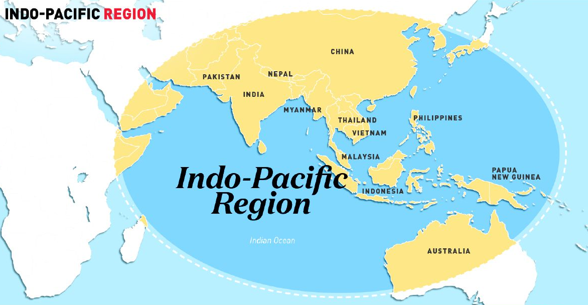
Strategy by European Union:
- Increased cooperation in the Indo-Pacific
- Commitment to uphold democracy, human rights, the rule of law and respect for international law.
- Promote effective rules-based multilateralism
- Support for ASEAN (Association of South East Asian Nations)
- Work to mitigate economic and human effects of the COVID-19 pandemic
- Support open and fair environment for trade and investment
- Tackling climate change and supporting connectivity with the EU
- Conclude free trade agreements with Australia, Indonesia and New Zealand
- Take steps towards the Comprehensive Agreement on Investment with China
- Deepen economic relations with India
- Develop partnerships in the areas of security and defence
- Address maritime security, malicious cyber activities, disinformation, emerging technologies, terrorism, and organised crime
- Extend the geographic scope of its CRIMARIO (Critical Maritime Routes) IIactivities from the Indian Ocean into South and Southeast Asia to contribute to safer sea lanes of communication with the EU.
Get an IAS/IPS ranker as your 1: 1 personal mentor for UPSC 2024
Attend Now
Note4Students
From UPSC perspective, the following things are important :
Prelims level: Article 123, Article 213 of the Indian Constitution
Mains level: Paper 2- Issues with the repromulgation of ordinances
Repromulgation of ordinances raises several questions and it also goes against the Supreme Court judgement. The article explains the issues involved.
Ordinance route and issues with it
- The central government has repromulgated the ordinance that establishes a commission for air quality management in the National Capital Region.
- This raises questions about the practice of issuing ordinances to make law, and that of re-issuing ordinances without getting them ratified by Parliament.
- Law making is a legislative function, this power is provided for urgent requirements, and the law thus made has an automatic expiry at the end of six weeks from the time Legislature next meets.
How frequent is the use of ordinance route
- In the 1950s, central ordinances were issued at an average of 7.1 per year.
- The number peaked in the 1990s at 19.6 per year, and declined to 7.9 per year in the 2010s.
- The last couple of years has seen a spike, 16 in 2019, 15 in 2020, and four till now this year.
- States have also been using the ordinance route to enact laws.
- For example, in 2020, Kerala issued 81 ordinances, while Karnataka issued 24 and Maharashtra 21.
- Kerala has also repromulgated ordinances.
What the Supreme Court said
- The issue was brought up in the Supreme Court through a writ petition by D.C. Wadhwa.
- He found out that Bihar had issued 256 ordinances between 1967 and 1981, of which 69 were repromulgated several times, including 11 which were kept alive for more than 10 years.
- A five-judge Constitution Bench of the Supreme Court, in 1986, ruled that repromulgation of ordinances was contrary to the Constitutional scheme.
- The judgment did not stop the practice.
- Instead, the Centre also started to follow the lead of Bihar.
- For example, in 2013 and 2014, the Securities Laws (Amendment) ordinance was promulgated three times.
- Similarly, an ordinance to amend the Land Acquisition Act was issued in December 2014, and repromulgated twice – in April and May 2015.
- The matter came up again in the Supreme Court in 2017, a seven-judge Constitution Bench declared this practice to be unconstitutional and declared it to be a fraud on the Constitution.
- Even this judgment has been ignored.
- The Indian Medical Council Amendment Ordinance was issued in September 2018, and reissued in January 2019.
Way forward
- Ordinances are to tackle exigencies when the legislature is not in session, and expire at the end of six weeks of the next meeting of the legislature.
- This time period is given for the legislature to decide whether such a law is warranted.
- Repromulgation is not permitted as that would be a usurpation of legislative power by the executive.
- As governments, both at the Centre and States, are violating this principle, the legislatures and the courts should check the practice.
- By not checking this practice, the other two organs are also abdicating their responsibility to the Constitution.
Consider the question “What are the issues with the repormulgation of ordinances by the government? Suggest the measures to deal with the issue.”
Conclusion
As the Supreme Court said, repromulgation would most certainly be a colourable exercise of power for the Government and it needs to be avoided.
Get an IAS/IPS ranker as your 1: 1 personal mentor for UPSC 2024
Attend Now
Note4Students
From UPSC perspective, the following things are important :
Prelims level: Not much
Mains level: Paper 2- Importance of Afghanistan in regional strategic matrix
The article highlights how players at 3 levels: global, regional and local level influence Afghan dynamics.
Role of global powers in Afghanistan
1) What the US exit from Afghanistan mean
- The exit of US and NATO forces from Afghanistan underlines the end of the unipolar moment in international affairs.
- Ending US military involvement, however, does not necessarily make Washington marginal to the future evolution of Afghanistan.
- The US remains the most significant global power even after the end of the unipolar moment.
- Its ability to weigh in on multiple issues is considerable.
- President Joe Biden is under some pressure at home not to be seen as abandoning Afghanistan.
- Nor can the US President ignore the dangers of Afghanistan re-emerging as a breeding ground for international terrorism.
- The US will figure prominently in any Taliban strategy to win international diplomatic recognition and political legitimacy.
- It will also need Western economic assistance for stabilising the war-torn country.
2) Russia’s role in Afghanistan
- Russia is determined to play an important role in the future of Afghanistan.
- As a member of the UNSC, the joint leader of the Shanghai Cooperation Organisation with China, and a major source of weapons, Russian clout is real.
- Above all, Putin brings plenty of political will to compensate for Moscow’s loss of superpower status as we have seen across the world, from Venezuela to Myanmar and Mozambique to Syria.
3) How China will benefit from the US withdrawal
- If the US is a distant power, China is Afghanistan’s neighbour.
- Unlike Russia, China can deliver massive economic resources to Afghanistan under the umbrella of the Belt and Road Initiative.
- China’s expanding relations with the different nations of the Gulf and Central Asia and a deep partnership with Pakistan lends much potential depth to Beijing’s role in Afghanistan.
- Both Kabul and the Taliban have seen China as a valuable partner in the pursuit of their divergent interests.
- Beijing has often talked of extending the China Pakistan Economic Corridor to Afghanistan.
- However, China is vulnerable to the extremist politics of the region that fan the flames of religious and ethnic separatism in its Xinjiang province.
Regional powers influencing Afghan dynamics
- One of the biggest concern about the Afghan future is the kind of influence Islamic radicals might regain in the country under Taliban rule and its consequences for the subcontinent, Central Asia, and the Middle East.
- Pakistan and Iran, which share long physical borders, have had the greatest natural influence on land-locked Afghanistan.
- When the Taliban ruled Afghanistan, Saudi Arabia and the UAE were the only countries other than Pakistan to recognise the government-run by its leader, Mullah Omar.
- They have taken a back seat in the current round of Afghan diplomacy, but would certainly return to the centre stage sooner than later.
- Meanwhile, bold Qatar and ambitious Turkey have injected themselves into the Afghan jousting.
Influence of local actors
- The local actors in Afghanistan have agency of their own.
- All of them know how to manipulate external powers for their own ends in Afghanistan.
- The image of the Taliban as a creature of the Pakistan army is misleading, the Taliban is quite capable of making independent deals with the rest of the world.
- The Taliban’s opponents, too, are likely to fight for their interests and will seek out external partners.
Consider the question “Discarding old hesitations and building new geopolitical coalitions will be critical for a successful Indian engagement with the Afghan microcosm. Comment.”
Conclusion
Several contentions unfolding in and around Afghanistan promise to reorder the region again. Delhi needs much strategic activism to secure its interests and promote regional stability in this flux.
Get an IAS/IPS ranker as your 1: 1 personal mentor for UPSC 2024
Attend Now
Note4Students
From UPSC perspective, the following things are important :
Prelims level: CAATSA
Mains level: Paper 2- India-Russia relations
Avoiding military alliances and retaining its strategic autonomy could help India play an important role in geopolitics at the same time maintaining the diversity in its relationships.
Transformation in India-Russia relations
- The principal objective of the Russian Foreign Minister was to prepare the ground for the visit of President Vladimir Putin later this year.
- The Indian perspective on the Indo-Pacific was conveyed to the Foreign Minister of Russia.
- India insists that its Indo-Pacific initiatives seek a cooperative order, that the Quad is not the nucleus of a politico-military alliance.
- A $1 billion Indian line of credit for projects in the Russian Far East and activation of a Chennai-Vladivostok maritime corridor were announced in 2019.
- The message was that India’s effort to restrain Chinese aggression is compatible with Russia’s vision of a Eurasian partnership.
- Russia remains unconvinced, either because it feels India’s words do not match its actions or because of its close ties with China.
China factor in India-Russia relations
- India is concerned about Russia’s China embrace, encompassing close political, economic and defence cooperation: Russia accounted for 77% of China’s arms imports in 2016-20.
- India’s apprehensions about their technology- and intelligence-sharing were heightened by Mr. Putin’s remark that he would not rule out a future Russia-China military alliance.
Russia-Pakistan relations
- Foreign Minister visited Pakistan directly after India — the first time a Russian Minister has done so.
- .He confirmed that Russia would strengthen Pakistan’s “counter-terrorism capability” .
- Russia is now Pakistan’s second-largest defence supplier, accounting for 6.6% of its arms imports in 2016-20.
- Their cooperation includes joint “counter-terrorism” drills and sharing perspectives on military tactics and strategic doctrines.
Factors to consider about defence cooperation with Russia
- Despite being a major defence supplier of China and Pakistan, Russia remains a major supplier of cutting-edge military technologies to India.
- The Stockholm International Peace Research Institute (SIPRI) records that Russia supplied 49% of India’s arms imports in 2016-20.
- SIPRI estimates that recent orders for Russian arms could boost future import figures. T
- his is a reality check.
- Defence cooperation is not a transactional exchange. Sharing of technologies and strategies is underpinned by a mutual commitment to protection of confidentiality.
- Sustainable defence cooperation is based on a credible assurance that what is transferred to our adversaries will not blunt the effectiveness of our weapons systems.
- In this already complex mix, the American sanctions legislation, CAATSA (Countering America’s Adversaries Through Sanctions Act), adds an external layer of complexity.
Criticality of geography influence India’s relationship with Russia and China
- The Eurasian landmass to India’s north is dominated by Russia and China.
- Strategic and security interests in Central Asia, West Asia and Afghanistan dictate our engagement with the region and the connectivity projects linking it, like the International North-South Transport Corridor through Iran.
- India cannot vacate this space to a Russia-China condominium (with Pakistan in tow), without potentially grave security consequences.
The broader geopolitical context
- The principal element in this is the drive for the superpower status of a powerful, assertive China.
- The U.S., as the pre-eminent superpower, seeks to retard this process.
- In a deviation from classical geopolitical strategy, the U.S. is taking on both China and Russia.
- This move is driving Russia and China together and arguably accelerating the move to bipolarity.
- Even so, the differentials in military, economic and political power across countries may complicate the emergence of two clear poles of the Cold War variety.
- A decline in Western hostility to Russia could add to the complexity, if Russia takes the opportunity to loosen the Chinese embrace and position itself as a pole in the multipolar world.
Consider the question “The depth of India’s relationship with Russia will depend on the willingness and capacity of both countries to show mutual sensitivity to core security concerns. Comment.”
Conclusion
India has to explore the space within these processes to maximise its global influence by steering clear of alliances and retaining the autonomy of policy.
Get an IAS/IPS ranker as your 1: 1 personal mentor for UPSC 2024
Attend Now
The Supreme Court recently asked the Centre to respond to allegations made in a Public Interest Litigation with respect to 3 crore ration cards being cancelled in the country because of the insistence on Aadhaar linkage and biometric authentication.
Key Points
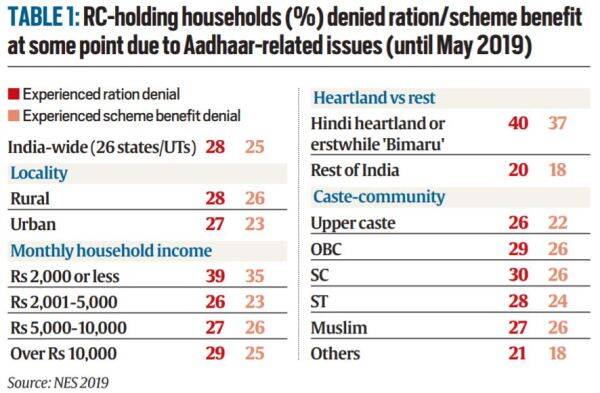
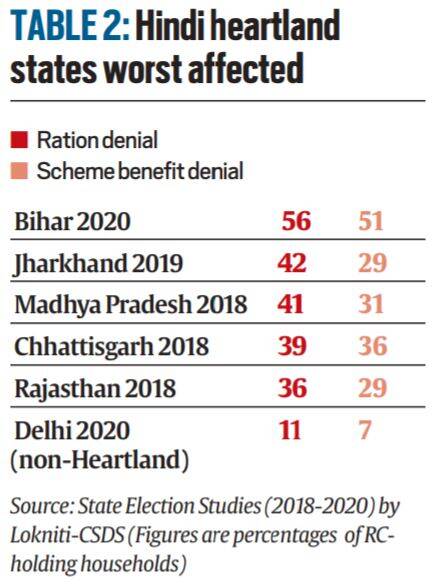
About Aadhar Card:
- Aadhar Card is basically a biographic and biometric data of Indian citizens that includes name, date of birth, gender, address, a photograph, and ten fingerprint and two iris scans.
- It includes a unique 12-digit Aadhaar number.
- The Aadhar Card is a residential proof and not a citizenship card.
Get an IAS/IPS ranker as your 1: 1 personal mentor for UPSC 2024
Attend Now
The Reserve Bank of India (RBI) constituted a committee to evaluate the role of asset reconstruction companies (ARCs) in stressed debt resolution and review their business model.
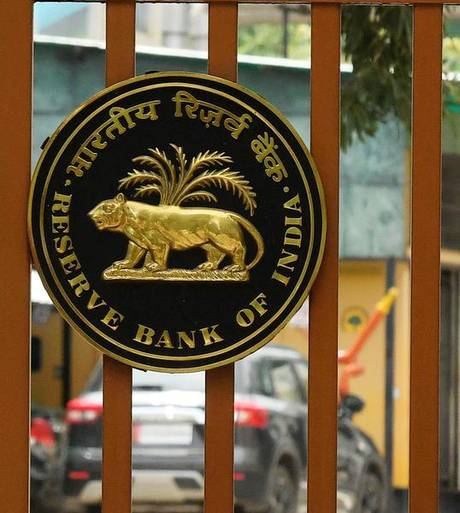
About the committee:
- It is a six-member committee that will be headed by Sudarshan Sen, former executive director, Reserve Bank of India (RBI).
Mandate:
- To review the existing legal and regulatory framework and recommend measures to improve the efficacy of ARCs.
- It will also review their role in stressed asset resolution under the Insolvency and Bankruptcy Code (IBC), and suggest means to improve liquidity and trading of security receipts.
- It has also been asked to review the business models of ARCs.
- The committee will submit its report within three months from the date of its first meeting.
Get an IAS/IPS ranker as your 1: 1 personal mentor for UPSC 2024
Attend Now
The Delhi High Court issued an order directing the Centre to take a decision on framing rules to confer protection for exotic animals that are currently not under the purview of the Wildlife (Protection) Act, 1972.
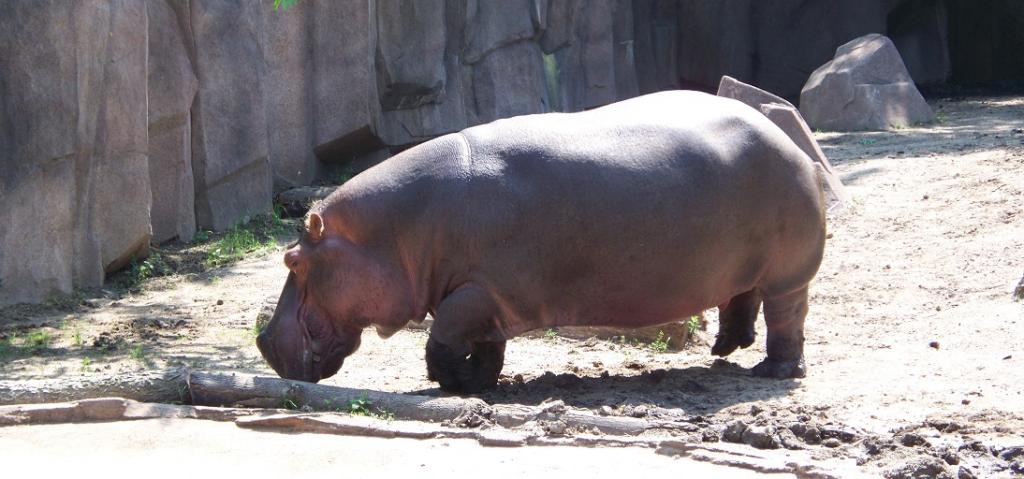
Key highlights:
- The court’s order came in response to a petition filed by animal rights group, People for the Ethical Treatment of Animals (PETA) India about the status of a male hippopotamus rescued from the Asiad Circus in Uttar Pradesh.
- The court directed that the hippo be permanently kept in a spacious facility in Jamnagar, Gujarat.
- The hippo was in the company of a rescued female hippopotamus and was receiving expert veterinary care.
- The facility met the Central Zoo Authority’s Guidelines on Minimum Dimensions of Enclosures for Housing Exotic Animals of Different Species and recommended that the facility be allowed to provide the hippopotamus with lifelong care.
About Hippopotamus:
- Hippopotamus is a large, mostly herbivorous, semiaquatic mammal and ungulate native to sub-Saharan Africa.
- It is one of only two extant species in the family Hippopotamidae, the other being the pygmy hippopotamus.
- After the elephant and rhinoceros, the hippopotamus is the third-largest type of land mammal and the heaviest extant artiodactyl.
- Despite their physical resemblance to pigs and other terrestrial even-toed ungulates, the closest living relatives of the Hippopotamidae are cetaceans from which they diverged about 55 million years ago.
Get an IAS/IPS ranker as your 1: 1 personal mentor for UPSC 2024
Attend Now
Recently, India and Germany signed Cities combating plastic entering the marine environment’.
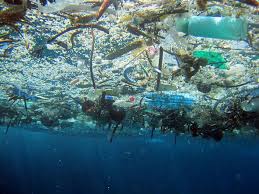
The agreement was signed by the Ministry of Housing and Urban Affairs and the respective ministry of Germany.
Key Points:
- The project envisaged under the contours of the Joint Declaration of Intent regarding cooperation in the field of ‘Prevention of Marine Litter’ signed between Republic of India and Federal Republic of Germany in 2019.
- It aims to prevent plastic entering the marine environment.
- Focus will be on three cities namely Kanpur, Kochi and Port Blair.
- Total time for the project is 3.5 years.
About Marine Litter:
According to UN Environment, marine litter is any persistent, manufactured or processed solid material discarded, disposed of or abandoned in the marine and coastal environment.
Sources:
- Items that have been made or used by people and deliberately discarded into the sea or rivers or on beaches.
- indirectly brought to the sea by rivers, sewage, storm water or winds.
- accidentally lost, including material lost at sea in bad weather (fishing gear, cargo)
- deliberately left by people on beaches and shores.
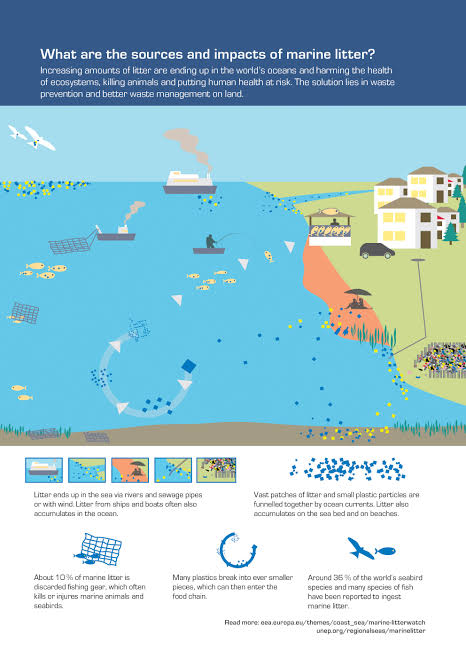
Impacts:
- Marine litter threatens ecosystems and adversely affects fishery and tourism industries around the globe.
- Affects public health with increased concerns about micro-plastic and risk of particles entering the food chain.
Suggestions
- Port reception facilities
- Creating a garbage management system
- Sewage treatment plants designed to capture plastic litter.
- Strict enforcement of norms preventing human led plastic waste discharge into aquatic and marine environments.
Get an IAS/IPS ranker as your 1: 1 personal mentor for UPSC 2024
Attend Now
The Ministry of Environment, Forest and Climate Change has cleared a rail project in the Western Ghats spread across Goa and Karnataka, which can endanger its wildlife.
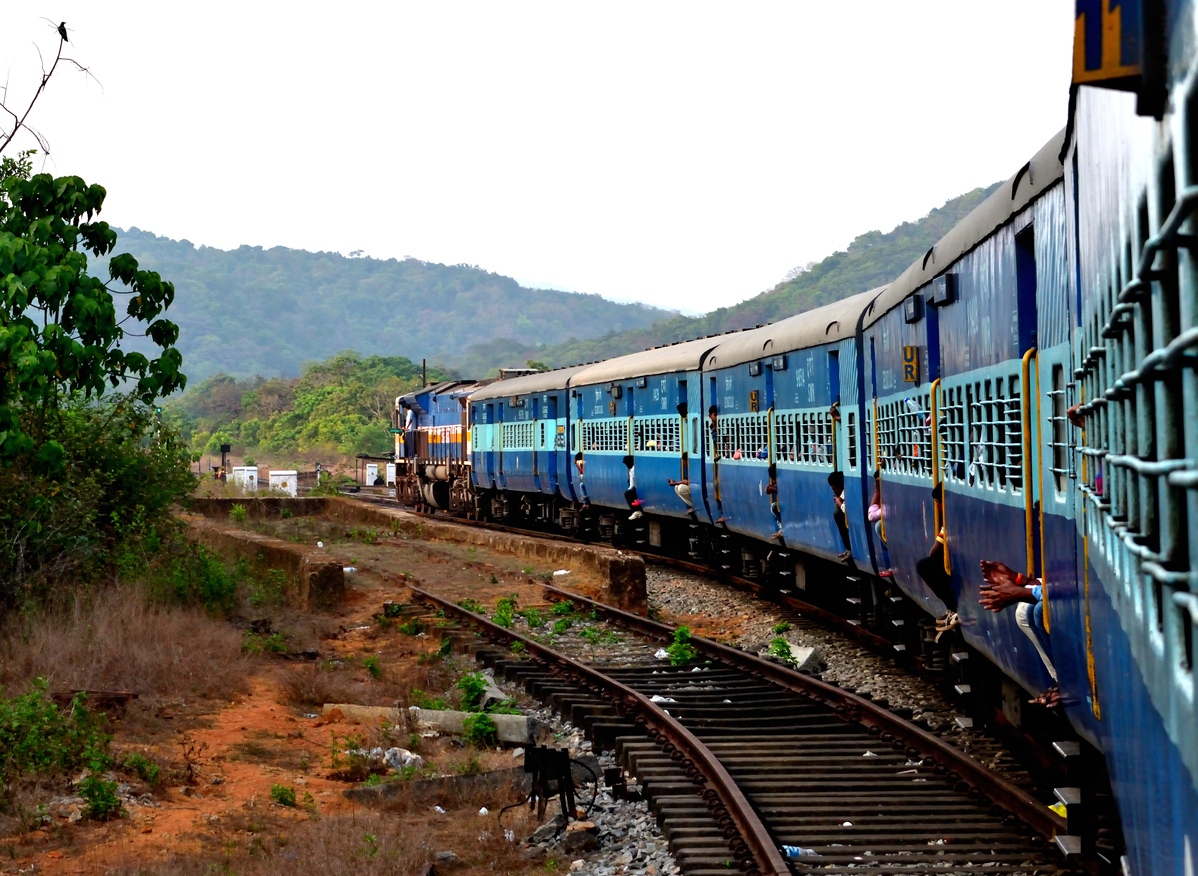
About the project:
- The project is the doubling the track of Hospet-Hubballi-Londa-Vasco Da Gama railway line by the Rail Vikas Nigam Ltd (RVNL).
- It involves doubling of the 353-kilometre-long railway track in Karnataka and Goa passing through the Western Ghats.
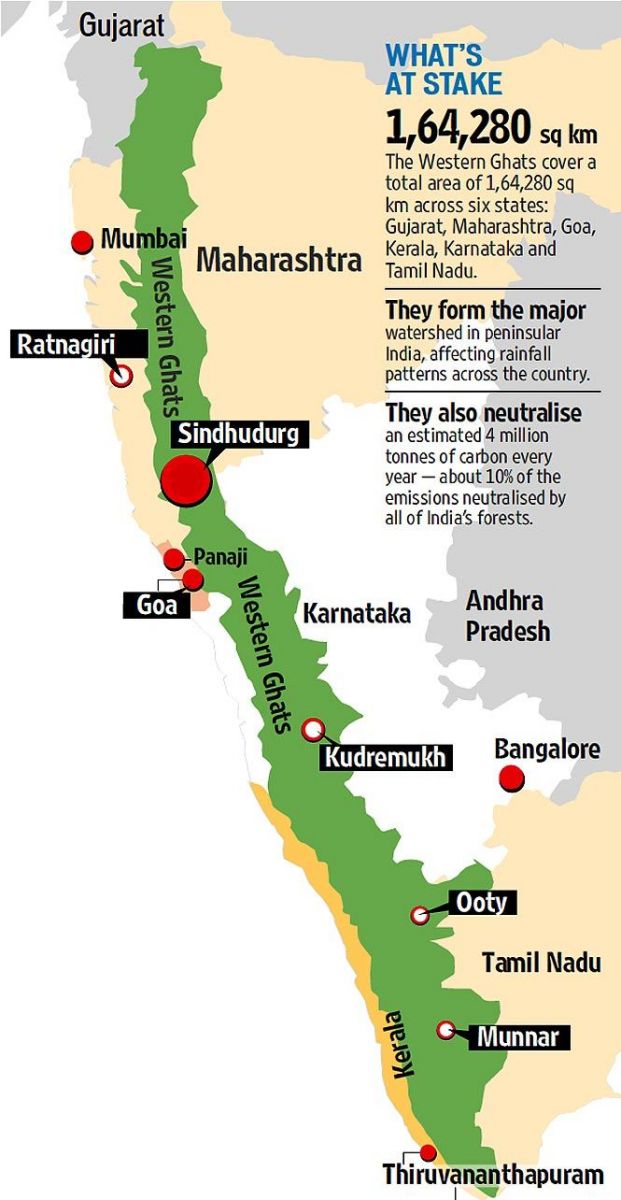
Western Ghats:
- The Western Ghats mountain range runs along the western side of India.
- The Ghats are older than the Himalayas.
- The range is known as Sahyadri in Maharashtra and Karnataka.
- It runs, about 1600 km, North to South, along the western edge of the Deccan Plateau.
- It originates near the border of Gujarat and Maharashtra, and runs through the states of Maharashtra, Goa, Karnataka, Tamil Nadu and Kerala, finally ending at Kanyakumari.
- These hills form the catchment area for complex riverine drainage systems that drain almost 40% of India.
- Height:
- The average elevation is about 1,200 m.
- Anaimudi (2695 m), is the highest peak of the Western Ghats, situated in Eravikulam National Park, Kerala.
- Rocks found:
- Basalt is the predominant rock found in the hills reaching a thickness of 3 km.
- Other rocks: Granite gneiss, metamorphic gneisses with detached occurrences of crystalline limestone, iron ore, dolerites and anorthosites.
- Major gaps in the range:
- Goa Gap between the Maharashtra and Karnataka sections.
- Palghat Gap on the Tamil Nadu and Kerala border between Nilgiri Hills and Anaimalai Hills.
- Recognitions:
- It is one of the eight hottest hotspots of biological diversity in the world.
- In 2012, thirty-nine places in the Western Ghats region have been declared as World Heritage Sites by the UNESCO.
- Flora and Fauna:
- There are at least 139 mammal species.
- It includes the critically endangered Malabar large-spotted civet and the endangered lion-tailed macaque.
Get an IAS/IPS ranker as your 1: 1 personal mentor for UPSC 2024
Attend Now
India has invoked the peace clause at the World Trade Organization (WTO), for the second time, for exceeding the 10 per cent ceiling on support it offered its rice farmers.
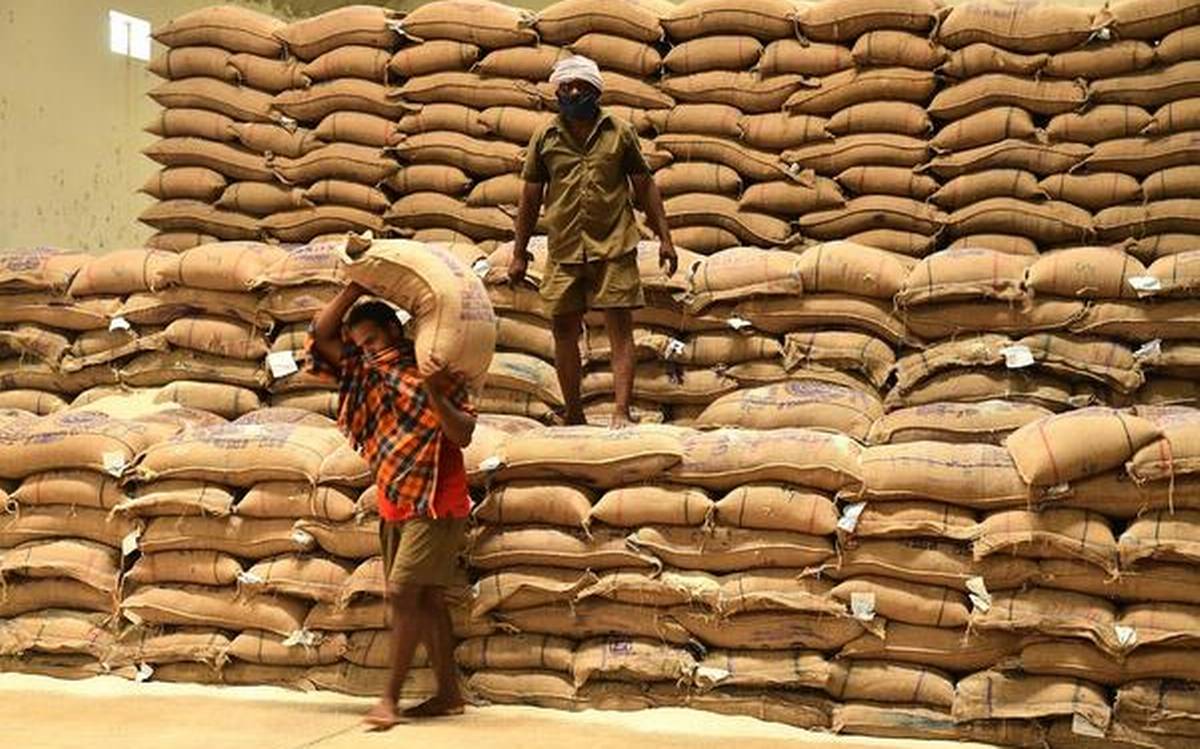
- India had earlier invoked the clause for 2018-19, when it became the first country to do so.
- India informed the WTO that the value of its rice production in 2019-20 was $46.07 billion while it gave subsidies worth $6.31 billion, or 13.7 per cent as against the permitted 10 per cent.
What is Peace Clause?
- The peace clause protects India’s food procurement programmes against action from WTO members in case the subsidy ceilings – 10 per cent of the value of food production in the case of India and other developing countries – are breached.
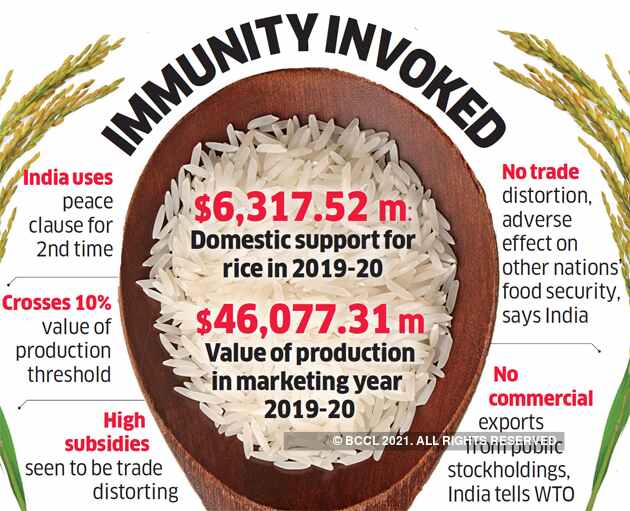
What does India told to WTO?
- India’s breach of commitment for rice arises from support provided in pursuance of public stockholding programmes for food security purposeswhich were in existence as on the date of the Bali Ministerial Decision on Public Stockholding for Food Security Purposes.
- India said that under its public stockholding programmes for food security purposes, rice, wheat, coarse cereals and pulses, among others, are acquired and released in order to meet the domestic food security needs of the country’s poor and vulnerable population, and “not to impede commercial trade or food security of others. For these reasons only the breach of the de minimis limits for rice is covered by the peace clause.
Government does not undertake exports on a commercial basis from public stockholdings. Additionally, open market sales of food grains from public stockholding are made provided the buyer gives an undertaking of not exporting from such purchase.
- The peace clause can’t be challenged and because of this flexibility, distribution of food grains to the poor can be done for free which is crucial during the pandemic.
- India ensures food security through the minimum support price (MSP) programme, and Public Distribution System and National Food Security Act, 2013.
Subsidies of WTO:
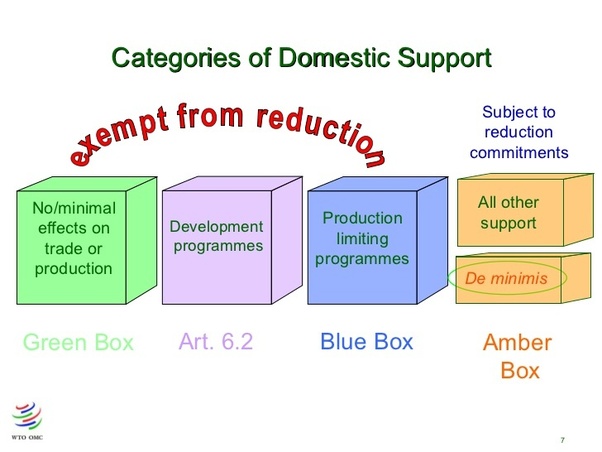
- In WTO terminology, subsidies in general are identified by “boxes” which are given the colours of traffic lights: green (permitted), amber (slow down — i.e. need to be reduced), red (forbidden).
- In agriculture, things are, as usual, more complicated.
- The Agriculture Agreement has no red box.
- Domestic support exceeding the reduction commitment levels in the amber box is prohibited
- There is a blue box for subsidies that are tied to programmes that limit production.
- There are also exemptions for developing countries (sometimes called an “S&D box” or “development box”, including provisions in Article 6.2 of the Agreement).
Amber Box:
- Nearly all domestic support measures considered to distort production and trade (with some exceptions) fall into the amber box, which is defined in Article 6 of the Agriculture Agreement as all domestic supports except those in the blue and green boxes.
- These include measures to support prices, or subsidies directly related to production quantities.
- These supports are subject to limits: “de minimis” minimal supports are allowed (generally 5% of agricultural production for developed countries, 10% for developing countries); 32 WTO members that had larger subsidies than the de minimis levels at the beginning of the post-Uruguay Round reform period are committed to reduce these subsidies.
- The reduction commitments are expressed in terms of a “Total Aggregate Measurement of Support”.
Blue Box:
- This is the “amber box with conditions” — conditions designed to reduce distortion.
- Any support that would normally be in the amber box, is placed in the blue box if the support also requires farmers to limit production (details set out in Paragraph 5 of Article 6 of the Agriculture Agreement).
- At present there are no limits on spending on blue box subsidies.
Green box:
- The green box is defined in Annex 2 of the Agriculture Agreement.
- In order to qualify, green box subsidies must not distort trade, or at most cause minimal distortion.
- They have to be government-funded (not by charging consumers higher prices) and must not involve price support.
- They tend to be programmes that are not targeted at particular products, and include direct income supports for farmers that are not related to current production levels or prices. They also include environmental protection and regional development programmes.
- Green box” subsidies are therefore allowed without limits, provided they comply with the policy-specific criteria set out in Annex 2.
Get an IAS/IPS ranker as your 1: 1 personal mentor for UPSC 2024
Attend Now
India’s antiquated animal cruelty law may finally get some teeth after around sixty years after its enactment.
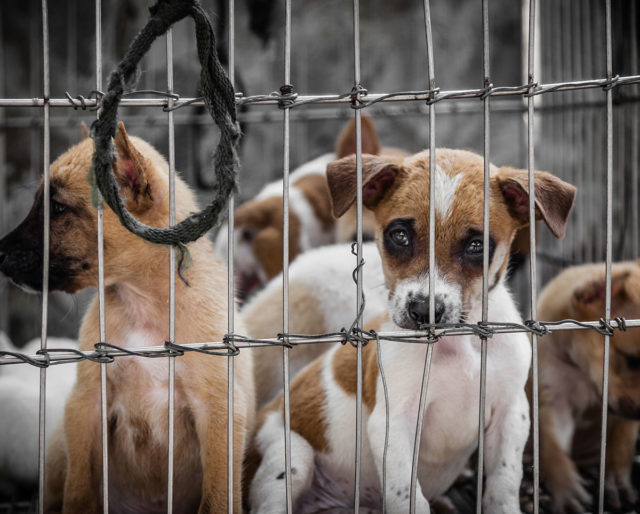
What are the amendments?
- The Centre’s Animal Husbandry department has suggested adding to the 1960 legislation a stringent new section that addresses the killing of animals and “gruesome cruelty” towards them.
- This section calls for imprisonment of up to five years and steep penalties that may go up to Rs 75,000.
- The department has also proposed amending the Prevention of Cruelty to Animals Act to hike the penalty for first-time offenders from the paltry “minimum of Rs 10 to maximum of Rs 50” to “not less than Rs 750 extended up to Rs 3,750 per animal”.
- The Union Ministry of Fisheries, Animal Husbandry and Dairying set the ball rolling for the amendment of the legislation with Joint Commissioner (AH) Dr S K Dutta inviting suggestions from stakeholders at a webinar.
Its proposed new section, meanwhile, has the following provisions—
- 11 (A): Gruesome cruelty or life-threatening cruelty against animals, for which the penalty is Rs 50,000 per animal or the cost of the animal as determined by a jurisdictional veterinarian. This carries imprisonment of one year which may extend to three years or both.
- 11 (B): Killing of an animal for which the penalty is Rs 75,000 per animal or three times the cost of the animal as determined by the jurisdictional veterinarian, whichever is more, with imprisonment of three years which may extend to five years or both.
- 11 (C): Exceptions (exemption to section 11 (B) killing of an animal): i) accident ii) in defence of self or property (iii) by an act of god or war (iv) any other unforeseen circumstance outside the control of any person in general.
Steps taken for welfare of animals in India:
- The Prevention of Cruelty to Animals Act 1960 recognises that animals can suffer physically and mentally, and is applicable to ‘all living creatures’.
- The Constitution also enshrines the principle of ahimsa and mandates to all citizens of India to ‘have compassion for living creatures’.
- The Animal Welfare Board of India (AWBI) is the central body responsible for animal welfare in the country.
- The National Institute for Animal Welfare created in 1999, has the broad mandate to improve animal welfare through research, education and public outreach.
Get an IAS/IPS ranker as your 1: 1 personal mentor for UPSC 2024
Attend Now
Note4Students
From UPSC perspective, the following things are important :
Prelims level: Species of bats
Mains level: Paper 3- Disk-footed bat recorded for first time in India
About the species
- A team of scientists from the Zoological Survey of India (ZSI) and a few European natural history museums stumbled upon very specialised small bat with “disk-like pads in the thumb and bright orange colouration”.
- The flattened skull and sticky pads enabled the bats to roost inside cramped spaces, clinging to smooth surfaces such as bamboo internodes.
- The disk-footed bat was also found to be genetically very different from all other known bats bearing disk-like pads.

Significance
- Meghalaya has yielded India’s first bamboo-dwelling bat with sticky disks, taking the species count of the flying mammal in the country to 130.
- The disk-footed bat has raised Meghalaya’s bat count to 66, the most for any State in India.
- It has also helped add a genus and species to the bat fauna of India.
- There are a couple of other bamboo-dwelling bats in India.
- But the extent of adaptation for bamboo habitat in this species is not seen in the others.
Get an IAS/IPS ranker as your 1: 1 personal mentor for UPSC 2024
Attend Now
Note4Students
From UPSC perspective, the following things are important :
Prelims level: Agriculture households in India
Mains level: Paper 3- Need to focus on India's actual farming population
The article highlights the ambiguity about the number of farmers in India and related issues.
How many farmers does India really have
- The Agriculture Ministry’s last Input Survey for 2016-17 pegged the total operational holdings at 146.19 million.
- The NABARD All India Rural Financial Inclusion Survey of the same year estimated the country’s “agricultural households” at 100.7 million.
- The Pradhan Mantri Kisan Samman Nidhi (PM-Kisan) has around 111.5 million enrolled beneficiaries.
- Agricultural households, as per NABARD’s definition, cover any household whose value of produce from farming activities is more than Rs 5,000 during a year.
- That obviously is too little to qualify as living income.
Who is real farmer
- Agricultural households, as per NABARD’s definition, cover any household whose value of produce from farming activities is more than Rs 5,000 during a year.
- That obviously is too little to qualify as living income.
- A “real” farmer is someone who would derive a significant part of his/her income from agriculture.
- This, one can reasonably assume, requires growing at least two crops in a year.
- The 2016-17 Input Survey report shows that out of the total 157.21 million hectares (mh) of farmland with 146.19 million holdings, only 140 mh was cultivated.
- And even out of this net sown area, a mere 50.48 mh was cropped two times or more, which includes 40.76 mh of irrigated and 9.72 mh of un-irrigated land.
- Taking the average holding size of 1.08 hectares for 2016-17, the number of “serious full-time farmers” cultivating a minimum of two crops a year would be hardly 47 million.
- The above figure is also consistent with other data from the Input Survey.
- These pertain to the number of cultivators planting certified/high yielding seeds (59.01 million), using own or hired tractors (72.29 million) and electric/diesel engine pumpsets (45.96 million), and availing institutional credit (57.08 million).
- Whichever metric one considers, the farmer population significantly engaged and dependent on agriculture as a primary source of income is well within 50-75 million.
- The current agriculture crisis is largely about these 50-75 million farm households.
Lack of price parity
- At the heart of farmers’ crisis is the absence of price parity.
- In 1970-71, when the minimum support price (MSP) of wheat was Rs 76 per quintal, 10 grams of 24-carat gold cost about Rs 185.
- Today, the wheat MSP is at Rs 1,975/quintal, gold prices are Rs 45,000/10g.
- The absence of farm price parity didn’t hurt much initially when crop productivity was rising.
- Since the 1990s, yields have further gone up to 5.1-5.2 tonnes/hectare in wheat and 6.4-6.5 tonnes for paddy. But so have production costs.
- The demand for making MSP a legal right is basically a demand for price parity that gives agricultural commodities sufficient purchasing power with respect to things bought by farmers.
Way forward
- Most government welfare schemes are aimed at poverty alleviation and uplifting those at the bottom of the pyramid.
- But there’s no policy for those in the “middle” and in danger of slipping to the bottom.
- When crop prices fail to keep pace with escalating costs — of not only inputs, but everything the farmer buys — the impact is on the 50-75 million surplus producers.
- Any “agriculture policy” has to first and foremost address the problem of price parity.
- Farmers’ interest be even better served by the government guaranteeing a minimum “income” rather than “price” support.
- Subsistence or part-time agriculturalists, on the other hand, would benefit more from welfare schemes and other interventions to boost non-farm employment.
Conclusion
Whether it is crop, livestock or poultry, agriculture policy has to focus on “serious full-time farmers”, most of them neither rich nor poor. This rural middle class that was once very confident of its future in agriculture today risks going out of business. That shouldn’t be allowed to happen.
Get an IAS/IPS ranker as your 1: 1 personal mentor for UPSC 2024
Attend Now
















